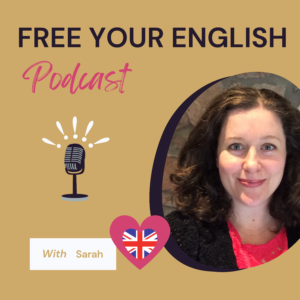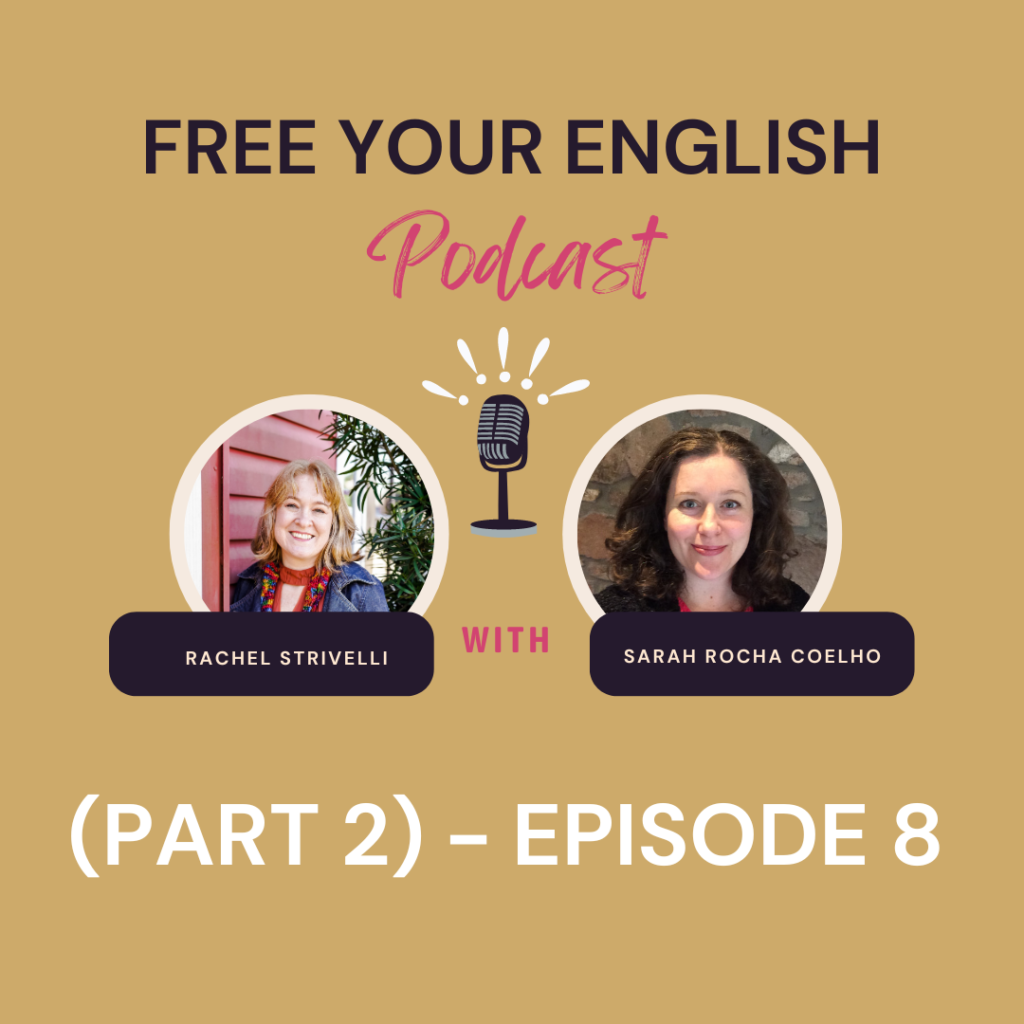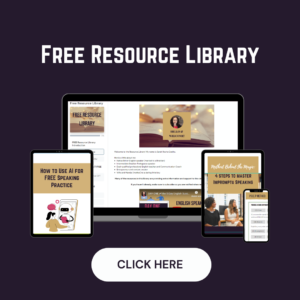Join me for episode eight. This episode is part two of my interview with my first-ever guest, Rachel Strivelli, a psychic, intuitive mentor, and author of “Talk to the Trees.” Rachel and I discuss the how she has navigated change throughout her career and what led to her writing her book.

Listen here on Spotify:
Watch this episode on YouTube:
Transcript:
Hello and welcome!
This week is part two of my first interview on the podcast. If you haven’t heard part one, I suggest you check out Episode Seven first.
My guest, Rachel Strivelli, is a psychic, intuitive mentor, and author of “Talk to the Trees.” Her specialty is helping spiritual entrepreneurs to gain clarity, feel grounded, and to take aligned action. Today, we’ll be talking about how she has navigated change in her career and what led her to write her book.
At the end of the podcast, I’ll give you a chance to look again at some of the vocabulary in the context that it was used.
Also, I want to just give you a quick reminder that, as always, I have a transcript of this episode on my blog which is useful to use as you listen as we both have very different accents.
The blog has an overview of some of the vocabulary used, as well as links to Rachel’s work online. You can find that in the show notes if you are listening on your Podcast player or in the video description if you are listening on YouTube. Okay, let’s dive in!
(Sarah):
How did you get into this work? How did it evolve for you?
(Rachel):
Oh, yes, yes, good question. So in my earlier days, I was an English teacher, which I really did enjoy, and also a science teacher, so I loved both of those. Maybe, the science I loved a little bit more, just because when students didn’t like the same books, or if I loved a book and it was a book I was teaching to my students and they didn’t like it, that broke my heart. But for some reason, with science, I could always find a way to get most of the people excited about it, and I love talking about the natural world being in the natural world.
So I was doing that for a number of years. And then when my first child was born, she’ll be 10 this year, I thought I was going to stay at home with her, have a big garden, craft, write, because I’ve always been writing something fiction or nonfiction on the side.
00:59
And I thought that would be my life, and I resigned from my teaching job. But it was clear a few months into it that it wasn’t enough for me. I didn’t… I felt a little bit unsettled and unhappy, even though my daughter was healthy, and I was happy being around her a little bit, but it just wasn’t the right fit in terms of I felt that intellectually I wasn’t stimulated enough. And … and so I got a babysitter who would come watch my daughter for a few hours a few times a week, and I started looking into what can I do to start a business. That way I’ll have my own hours, and I knew I had a lot of skill sets.
And so first I just started freelancing and looked into things related to education and editing and things of that nature. And pretty quickly after that, I realized, well, I have all this background in organic agriculture, and being a Science teacher, and I’ve been organic gardening for 20-plus years, I can start teaching people. And people were always asking me questions about the garden anyway. So it seemed like a natural place. And so I started doing that part-time, and it felt successful. But a lot of the questions people had were about getting their garden started. And once everybody had their garden in the ground, then they didn’t need my help as much. Sometimes, I would come and help them in the middle of the season if there were a lot of pests or things were happening and they didn’t know what to do. But I realized, okay, this isn’t… this is nice that I started something, and it seems like it’s working, but it’s not the best fit.
02:55
So I started reflecting again, and I realized, well, I loved the encouraging part of what I was doing. And similar to the teaching – bringing out people’s potential. And in a lot of ways, what I also realized was similar to what we’ve already talked about, life coaching, a lot of it involved me being present to somebody going through something new and giving them permission to make mistakes, permission to fail, permission to say, this means a lot to me. I’m gonna learn a little bit about it, and I’m gonna try it out. And I’m not gonna let the fact that I’m a beginner stop me from getting involved in something that I really want to do.
03:40
So maybe you’re kind of like an English life coach, because I already feel like how you’re supporting people similar to what I did with life coaching of, let’s break it down into steps. Let’s be accountable, be okay with making mistakes, and getting yourself in a community where there’s other people who are doing the same hobby or activity or belief or lifestyle that you really aspire to.
04:12
(Sarah):
Absolutely, there’s so much that’s very similar. You know, when you were talking about a big piece of what you do is helping people take aligned action, those exact words are the exact words that I use in my Speak English with Confidence course. It’s all about getting people to start with “How do they cultivate calmness in their life?” because we really practice feeling stressed as speakers, you know, English speakers or whatever language you’re trying to speak. We imagine it and we have like this complete awareness of what it feels like to be stressed when you’re speaking. But we don’t actually practice the calm and you can’t reach for that calmness if you’re not allowing it into your life in other ways. And so we start with cultivating calmness.
We talk about from there, you can create aligned action. You know, things that are actually a big yes for you, um, from that place of really knowing what you want. So yeah it’s very similar. And I think that’s what drew me to your book as well is this idea of, um, you know, a very unique way of cultivating calmness.
So I mean, that’s a big question that I want to ask you is like, what, what led you, I know what drew me to your book. I … I’m fascinating… fascinated by, um, trying to find different ways of cultivating calmness in my own life. I sometimes feel like a hypocrite, like I don’t have it down. I don’t have it mastered, but I’m still seeking and trying and, you know, continually trying to add to things, but yeah.
What led to you writing this, this book?
05:49
(Rachel):
That’s such a great question. And before I fully dive into it, I want to say, I don’t know that any of us, even if we master the calmness, something in life seems to always change anyway eventually. I felt that I was so good with, with being calm and handling the pressures of life. And then my second child was born and I was like, “whoa.” And then a year after that, the pandemic happened. And I said, “whoa,” again, and it, and it made me realize even more, okay, it’s okay to change. It’s okay that sometimes what worked for cultivating calmness in a certain stage of life, maybe it’ll work again in another stage, but it’s not working right now. But what can work right now?
And so this book, talk to the trees really arose… probably the first seed of it was with the pandemic. When I realized there were so many unknowns happening and I didn’t want to be a stay-at-home mom, but because of the way the lockdown was, both of my children were at home again, full time. And, and I… I was just looking at them sometimes like: how am I supposed to work when you’re here? And I thought he would be somewhere else. And my son was two so he, even now he won’t sit in front of a TV or a computer or screen for very long, but then he… he just wouldn’t do it at all.
07:21
And so I kept on thinking, how can I connect to calmness again? In this state where it feels like there’s a lot of topsy-turvy upheaval of emotions happening and all throughout my life, actually in some of the most challenging moments, I like to go find a quiet place in nature and sit and, and I pretty much just sit till I feel better. And, and it does seem always that there’s a tree there.
And so, so one day I was out on my back porch and just gazing up at the trees. And I thought, okay, these trees, they’ve had all kinds of storms. They’ve lived through life’s ups and downs. Let me learn from the trees. And then I love to doodle trees because also sometimes when my brain or my emotions are running around anxious, scattered, worried, overwhelmed, frantic, doing something like calmly doodling a tree – I’m sure all of the things that lower stress are happening, lowers my blood pressure, lowers my breathing, calms me down. And, and trees are so beautiful. So, so all of that was a little bit of the context.
Okay, now that you have heard the part of the interview that I am using for this week’s podcast episode, I invite you to consider testing your understanding of some of the vocabulary that was used. I’ll read out a section of the interview and give you multiple choice definitions for you to choose from. Ready?
Q1. In the interview, I said: “I’m fascinated by trying to find different ways of cultivating calmness in my own life. I sometimes feel like a hypocrite, like I don’t have it down.
Here’s another example:
E.g. After hours of practice, she finally had the guitar solo down perfectly for the concert.
What does the phrasal verb “to have something down” mean?
a) To have achieved perfection or mastery in something
b) To be uncertain or confused about something
c) To be hypocritical or insincere in one’s actions
Correct answer: a) To have achieved perfection or mastery in something
Sometimes we use the full expression: to have something down pat. That really means that you have it perfected so much you don’t need to think about it at all.
Q2. Rachel said: “And so I kept on thinking, how can I connect to calmness again? In this state where it feels like there’s a lot of topsy-turvy upheaval of emotions happening…”
Here’s another example:
E.g. The unexpected news turned their lives topsy-turvy, causing confusion and upheaval in their daily routines.
What does “topsy-turvy” mean?
a) Calm and peaceful
b) Chaotic and disorganized
c) Serene and harmonious
Correct answer: b) Chaotic and disorganized. It’s the same as saying that things are “upside down.”
Don’t forget that a really good practice to get into when you’ve finished listening is to take a minute to speak aloud a summary of what the podcast was about. That’s always a really good test of understanding.
Thanks so much for listening. Please do hit subscribe and like if you are listening on YouTube or consider writing a great review if you are listening on a Podcast player. Come say “hi” on Facebook or Instagram and please do join us for the next episode as Rachel and I finish up our conversation.
Connect:
You can connect with Rachel and find more of her content and work here:
Vocabulary:
To break someone’s heart (phrase) = to overwhelm someone with sadness.
E.g. “…when students didn’t like the same books, or if I loved a book and it was a book I was teaching to my students and they didn’t like it, that broke my heart.”
E.g. As a child, seeing her best friend move to another city broke her heart as they’d been so close.
A number of (idiomatic noun phrase) = a collection of people or things; similar to “several” or “many.”
“I was doing that for a number of years.”
E.g. I saw a number of movies during my week off.
To have / get something down (phrasal verb) = to master something or achieve a high level of skill.
“I sometimes feel like a hypocrite, like I don’t have it down.”
I used to struggle with parallel parking but now I have it down and can park anywhere.
Topsy-turvy (adjective) = a state of confusion, disorder or chaos.
“In this state where it feels like there’s a lot of topsy-turvy upheaval of emotions happening”
E.g. The living room was in a topsy-turvy state by the time the kids finished playing.
Ups and downs (noun) = a mixture of good and bad things.
“They’ve lived through life’s ups and downs.”
E.g. They had a good relationship even though their marriage had certainly seen some ups and downs.
Your next steps:
Make sure to access my FREE Resource Library to take action towards gaining the confidence and clarity in English that you desire.
Click the image below:

